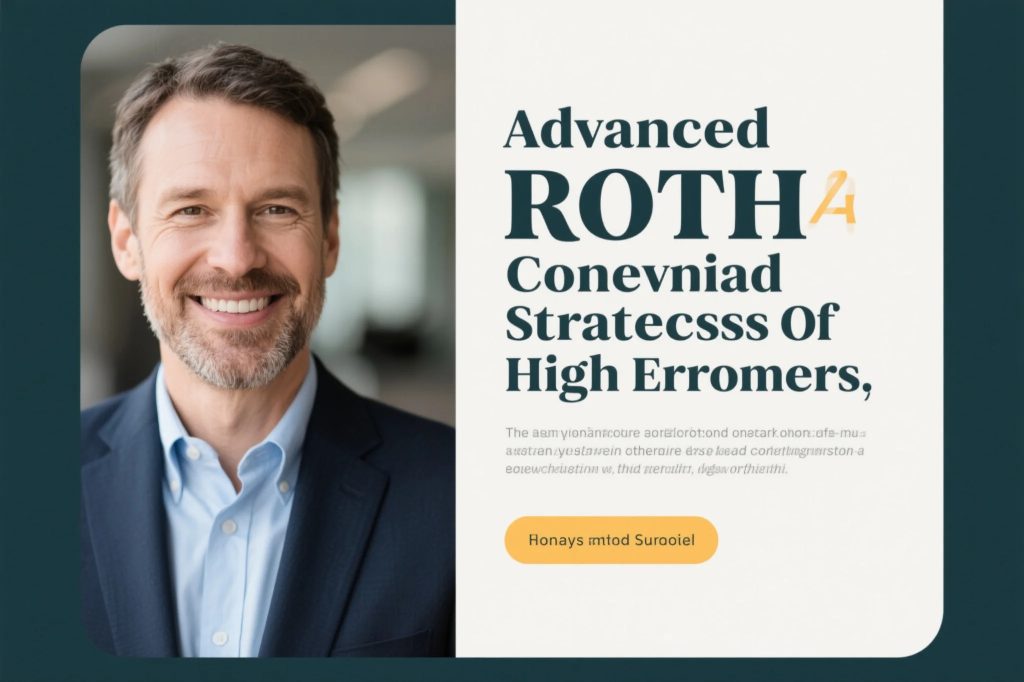
the evolving landscape of roth conversions for high earners
For high income professionals and business owners, Roth conversion strategies have become increasingly sophisticated in recent years, evolving far beyond simple all-or-nothing decisions about traditional IRA balances. The current tax environment, with historically low rates scheduled to sunset after 2025, has created a unique window of opportunity for strategic wealth transfers. What many affluent investors fail to realize is that partial conversions can be precisely calibrated to fill up specific tax brackets each year, optimizing the trade-off between current tax costs and future tax-free growth. This granular approach requires careful analysis of projected income streams, existing tax deferral balances, and anticipated spending needs in retirement planning scenarios.
The mathematics behind these strategies reveals why they’re particularly powerful for high income individuals. While the upfront tax bill from conversions can be substantial, the decades of tax-free compounding that follow often more than compensate – especially for those who expect to remain in high tax brackets during retirement or anticipate rising tax rates. Sophisticated planners now model various conversion scenarios across multi-year time horizons, factoring in variables like required minimum distributions, Social Security taxation, and potential changes to estate tax laws. The most effective approaches don’t view conversions in isolation but integrate them with broader retirement planning and wealth transfer strategies.
advanced backdoor roth techniques
The backdoor IRA strategy remains a vital tool for high income earners prohibited from making direct Roth contributions, but its implementation has grown more nuanced in recent years. Savvy investors now employ “mega backdoor” techniques through employer-sponsored 401(k) plans that allow after-tax contributions up to $69,000 in 2025 (including catch-up contributions for those 50+). This powerful strategy involves making after-tax 401(k) contributions beyond the standard deferral limit and immediately converting them to Roth status, creating a substantial tax-free growth vehicle that bypasses normal income restrictions.
What makes these backdoor IRA strategies particularly compelling is their interaction with other elements of retirement planning. When coordinated with traditional Roth conversions, they can help create a tax-diversified retirement income stream that provides flexibility in managing future tax liabilities. However, these techniques require careful navigation of the pro-rata rule and other IRS regulations that can create unexpected tax consequences if not properly managed. The most successful implementations involve meticulous record-keeping and often benefit from professional guidance to avoid costly mistakes.
tax bracket optimization strategies
Sophisticated Roth conversion planning involves precise calibration to optimize within the tax deferral system’s graduated brackets. High earners often employ “bracket topping” strategies where they convert just enough each year to reach the top of their current marginal bracket without spilling into higher rates. This approach requires detailed projections that account for all income sources, deductions, and credits to identify the ideal conversion amount. Some investors alternate between larger conversion years and smaller ones, coordinating with fluctuations in business income or investment gains to smooth out their tax burden over time.
These optimization strategies become particularly powerful when integrated with other elements of retirement planning. For example, some high income individuals accelerate conversions during years when they have unusually high deductions or business losses that would otherwise go unused. Others time conversions to coincide with the years between retirement and the start of Social Security or required minimum distributions – a period sometimes called the “sweet spot” for Roth conversions. The most advanced planners even coordinate conversions with charitable giving strategies, using donor-advised funds to offset conversion income in high-tax years.

managing the pro-rata rule and ira aggregation
One of the most complex aspects of backdoor IRA strategies and Roth conversions for high income investors involves navigating the IRS’s pro-rata rule. This regulation requires that all traditional IRA balances (including SEP and SIMPLE IRAs) be aggregated when calculating the taxable portion of any conversion. Many successful professionals discover too late that years of deductible IRA contributions or rollovers from old 401(k) plans have created substantial pre-tax balances that make backdoor Roth strategies prohibitively expensive from a tax perspective.
Creative solutions to this challenge have emerged as cornerstones of advanced retirement planning. Some individuals reverse the damage by rolling pre-tax IRA funds into current employer 401(k) plans if permitted, effectively clearing the deck for clean backdoor Roth contributions. Others implement multi-year conversion strategies that systematically address their pre-tax balances while managing the tax impact. The most sophisticated approaches involve modeling various conversion scenarios across a decade or more, gradually shifting assets from tax-deferred to tax-free status in the most efficient manner possible given their overall tax deferral situation.
estate planning considerations for roth assets
The estate planning benefits of Roth accounts add another layer of strategic consideration for high income families. Unlike traditional IRAs that eventually face required minimum distributions, Roth IRAs can continue growing tax-free throughout the owner’s lifetime and pass to heirs with favorable tax treatment. This makes Roth conversions particularly attractive for those focused on wealth transfer, as paying conversion taxes now effectively prepays the tax liability for future generations. The calculus changes significantly when considering the current tax deferral benefits versus the long-term multigenerational advantages.
Sophisticated estate planning strategies often involve staggering conversions over multiple years to avoid pushing the original owner into unnecessarily high tax brackets while still maximizing the tax-free legacy. Some families establish irrevocable trusts as Roth IRA beneficiaries to extend the tax-free growth period even further beyond the normal 10-year distribution rule for non-spouse heirs. These approaches require careful coordination with overall retirement planning objectives and should be reviewed regularly as tax laws and family circumstances evolve.
coordinating conversions with investment strategies
The timing and sizing of Roth conversions should be carefully coordinated with broader investment considerations for high income investors. Market downturns present unique opportunities to convert assets at depressed values, effectively transferring more future growth potential into the tax-free Roth environment for each tax dollar spent. Some investors maintain “conversion watch lists” of holdings they’d like to move to Roth status when valuations become attractive, combining tax strategy with investment selection.
Asset location strategies also interact powerfully with conversion decisions in comprehensive retirement planning. Investments with the highest expected returns are often prioritized for Roth accounts since their growth will never be taxed, while more stable or income-producing assets might remain in traditional tax deferral accounts. Some investors even adjust their overall asset allocation to account for the different tax treatments of various account types, recognizing that a dollar in a Roth IRA is worth more after-tax than a dollar in a traditional IRA.
state tax considerations in conversion planning
For high income individuals in high-tax states, Roth conversions require additional layers of analysis beyond federal tax brackets. Some states don’t tax retirement income at all, making conversions during working years potentially less attractive for residents who plan to relocate in retirement. Others have their own version of the backdoor IRA rules that must be navigated carefully. The interplay between federal and state taxation can significantly impact the optimal timing and amount of conversions.
Creative planning solutions have emerged to address these complexities in retirement planning. Some taxpayers time conversions for years when they’re temporarily resident in low- or no-tax states. Others implement multi-year conversion strategies that account for anticipated changes in residency. The most sophisticated approaches model various scenarios that consider both current state tax implications and potential future changes to state tax laws, creating flexible plans that can adapt as circumstances evolve.
preparing for potential tax law changes
The scheduled sunset of current tax deferral provisions after 2025 adds urgency to Roth conversion planning for high income individuals. Many tax professionals anticipate higher ordinary income tax rates in future years, making the current period potentially the most favorable window for conversions in our lifetimes. However, this outlook must be balanced against the possibility that Congress could change Roth rules or impose new restrictions on large balances.
Forward-looking retirement planning in this environment often involves implementing flexible conversion strategies that can be adjusted as legislative clarity emerges. Some investors are front-loading conversions in 2024-2025 to lock in current rates while maintaining optionality for future years. Others are structuring partial conversions that create tax diversification without overcommitting to any single scenario. The most sophisticated approaches combine rigorous tax modeling with ongoing monitoring of legislative developments, allowing for mid-course corrections as the political and fiscal landscape evolves.